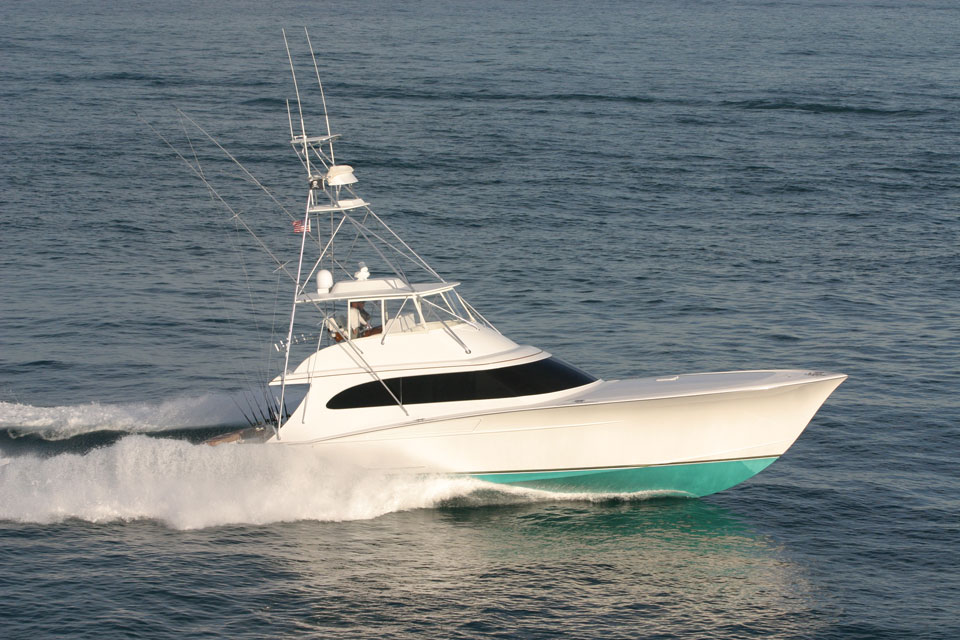
Double B
D – D was a straightforward repower. “To get the engines out, we took the manifolds and turbos off. The 8V92’s flywheel housing is 32 inches and the salon door is 34 inches with the doorjambs off,” says Charlie Schloemer, president of Palm Beach Power. The narrower Series 60 slid right in.
Simple fiberglass and wood stringers common as engine beds in ’84 were capped with aluminum structures similar to the way engines are mounted in new boats today. Old 2-cycle Detroit Diesel engines typically require larger exhausts than their new 4-stroke counterparts, so the boat needed only new risers between turbo and muffler. Hatteras tended to overbuild a bit, so the original 2 1/2-inch Aquamet shafts were more than adequate.
Schloemer suggests new transmissions, purchased as a package with engines so covered under warranty, rather than trying to rebuild old transmissions.
“When I quote a repower, I include any work that should be done to the support system for the new engines,” Schloemer says. “Fuel lines and filters, batteries and cables, all that needs to be looked at. When everything is out of the way, that’s also the time to look at generators, water heaters, air conditioners, anything that is normally hard to access.”
Double B (above, right) was also a straightforward job. “We always leave a little extra room when we build a boat,” says Paul Spencer, president of Spencer Yachts. “That’s why we could put in a little longer and taller motor. It would be a mistake to think a boat like that would never be repowered.”
Exhausts were increased 2 inches in diameter, but shaft size wasn’t increased. “With the added horsepower, we find a tendency to crack the shaft at the keyway in the taper,” Spencer says. “We could have increased to a 3 1/2-inch shaft, but that’s somewhere near double the weight plus added drag,” he said. “Instead we switched to a splined taper. They seem to hold the horsepower well.”
Spencer says such details won’t be overlooked with the right yard. “A lot of people make the mistake of choosing the cheapest bid,” he says. “You want to make sure everything is done so it looks like the boat was built that way, not like it was a redo. There is always a way to do the job right and still make it look nice.”
The Alessa Leigh rebuild started as a fairly quick trip to the yard. “The project started with just a bucket,” says Chad Delannoy, Bell’s long-time captain and project manager. A bucket is what west-coasters call a fiberglass crow’s nest above the helm that serves the same purpose as an East Coast tuna tower. The original bucket design would have weighed 2,000 pounds, unacceptable since they were removing only an 800-pound Hatteras-original radar and antenna mast. Instead, the entire bucket was kept to 900 pounds using carbon fiber.
“That took about three weeks to design and four months to build,” Delannoy says. “Then Scott [Bell, the boat’s owner] heard about the new 2,400-horsepower engines from MTU.” Bell employed naval architects and engineers, and tank-tested several designs before settling on a 9-foot extension with much less pitch in the propeller pocket tunnels (from a 9-degree down angle to 2 1/2 degrees).
“Then Scott said, I love the cockpit and the engines, but I don’t like my interior,” Delannoy says. “In one conversation we were removing the entire interior from the vessel.” Every piece that could be lightened was. Cored structures and carbon fiber were used for everything, including cabin soles. “At one point I was standing in the engine room looking up at the sky,” Delannoy says.
Much of the interior became structural, yet to utilize every inch of space, nothing was committed to paper plans in advance. “I’d work with a carpenter for a week to mock up a section of the interior in plywood and cardboard and Styrofoam,” he says. “The Bells would come by and tweak it, and then we’d involve Tim Nolan, the engineer.”
Noise and vibration mitigation were as much a priority as saving weight, “Particularly in the master stateroom,” Delannoy says. “Scott wasn’t concerned with how we did it, but that was a priority.” Bulkheads attached to the hull only with vibration-deadening strips, vibration-isolated platforms upon which equipment was mounted with additional vibration-isolating mounts, sound-absorbing sprayed coatings, and pumps and equipment chosen in part for quiet operation satisfied Bell’s mandate — to never hear a pump or motor while in his stateroom. Sound at 20 knots on the bridge also stayed below 60 decibels.
For long excursions far offshore, redundancy was another mandate. “There isn’t a system aboard that doesn’t have a backup,” Delannoy says. “One was never enough, two was better, and in some cases we have three. Scott has one wife, but at least two of everything else.”









